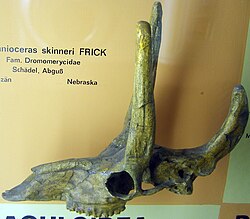Palaeomerycidae
| Palaeomerycidae Temporal range: Eocene–Miocene |
|
|---|---|
 |
|
| Cranioceras skinneri skull at the Museum für Naturkunde, Berlin | |
| Scientific classification | |
| Kingdom: | Animalia |
| Phylum: | Chordata |
| Class: | Mammalia |
| Order: | Artiodactyla |
| Suborder: | Ruminantia |
| Family: |
†Palaeomerycidae Lydekker, 1883 |
The Palaeomerycidae are an extinct family of ruminants (thus being even-toed ungulates of the order Artiodactyla), probably ancestral to deer and musk deer. Palaeomerycids lived in North America, Europe, Africa, Asia, and South America from 55.8 to 4.9 million years ago (from the Eocene to Pliocene epochs), existing for about 50 million years.
Specimens of Amphitragulus, the earliest known genus, have been found in Aragon (Spain), Ronheim (Germany), Sardinia (Italy), France, and Kazakhstan and range from 55.8 to 15.97 million years old. Fossils of Lagomeryx and Palaeomeryx feignouxi were recovered in Germany and Slovakia from the Middle Eocene.
The oldest known North American specimen, Barbouromeryx, was discovered in Scotts Bluff, Nebraska, and estimated at 23.03 million years old. Palaeomerycids such as Cranioceras and other Dromomerycinae continued to live in North America until the early Pliocene.
Palaeomerycids were a group of horned, long-legged, heavy, and massive ruminants that could attain a weight of 350 to 500 kg (770 to 1,100 lb).
...
Wikipedia
